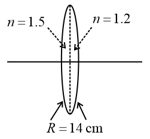EASY
Earn 100
An object gets closer to the focal point of a convex lens from infinity, its image
(a)becomes smaller
(b)is magnified
(c)becomes closer to this lens
(d)becomes further from the lens
50% studentsanswered this correctly
Important Questions on Eye and Optical Instruments
HARD
EASY
EASY
MEDIUM
EASY
EASY
MEDIUM
EASY
EASY
EASY
EASY
EASY
HARD

MEDIUM
EASY
EASY
EASY
MEDIUM
MEDIUM
EASY

